#South American animals
Text
Atelocynus microtis
This odd-looking canine is called a short-eared dog. They are so elusive, though, that they are often called “ghost dogs.” Sightings of them are very rare, which makes research on them difficult.

There’s been a lot of confusion over what the short-eared dog is. It used to be in the lycalopex genus with the zorros and the cerdocyon genus with the crab-eating fox, who it resembles, but now it’s in its own genus- atelocynus.
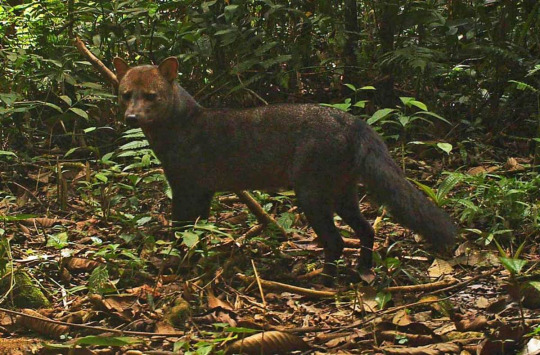
Short-eared dogs live in the Amazon rainforest in Peru, Columbia, Ecuador, Bolivia, and Brazil. They try to live far away from people, making them highly susceptible to habitat loss. Because of this it is suspected that their population is decreasing, but because sightings of them have always been rare it’s hard to estimate how many are left.
Studies of short-eared dog scat suggests that they eat lots of fruit, rodents, and fish. The fish in their diets along with their partially webbed feet could mean that short-eared dogs spend a lot of time in water, similar to the bush dog.
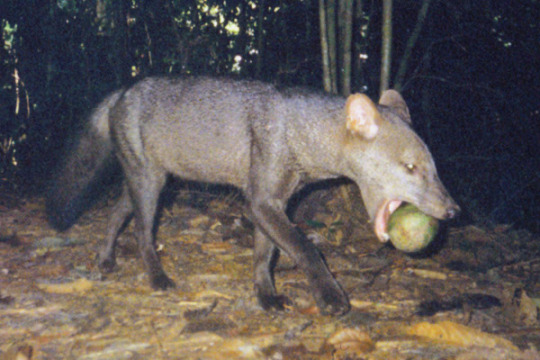
Much of what is known about these elusive animals comes from one short-eared dog named Oso, who was found when he was a puppy by a logger. He was then raised with pet dogs until a wildlife veterinarian named Renata Leite Pitman took over his care. By observing how Oso found food and interacted with other animals, Pitman learned about parts of the short-eared dogs’ life that scientists previously knew almost nothing about.
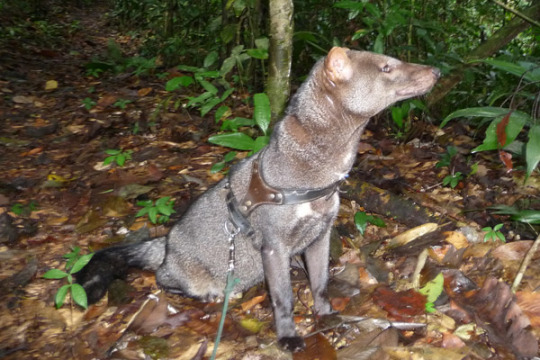
Before Pitman’s work with Oso, virtually nothing was known about short-eared dog vocalization, or the sounds they make. The veterinarian observed that Oso was very quiet but whined or “roared” when he was uncomfortable, and he occasionally made an unusual call that was “similar to some species of owl calls.”
When Oso was around 4 years old he was released into the wild with a tracker, allowing researchers to continue to learn about short-eared dogs.
I rate these very mysterious ghost dogs 13/10. They have a very distinctive look.

Photo credits:
(1) Galo Zapata-Rios (2) Owlcation (3) Renata Leite Pitman (4) Renata Leite Pitman (5) eMammal
#short eared dog#animal#animals#nature#wildlife#canine#wild animals#world#canid#dog#South America#South American animals#short-eared dog#canines#long post sorry
2K notes
·
View notes
Text
Atelocynus microtis
This odd-looking canine is called a short-eared dog. They are so elusive, though, that they are often called “ghost dogs.” Sightings of them are very rare, which makes research on them difficult.

There’s been a lot of confusion over what the short-eared dog is. It used to be in the lycalopex genus with the zorros and the cerdocyon genus with the crab-eating fox, but now it’s in its own genus- atelocynus.
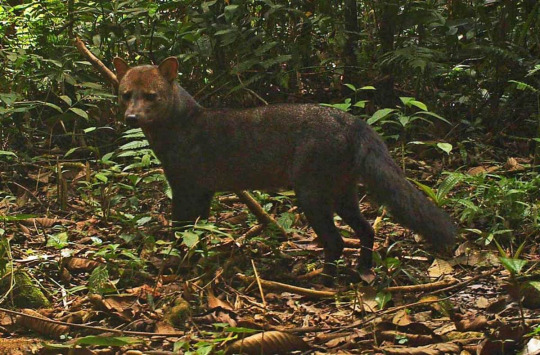
Short-eared dogs live in the Amazon rainforest in Peru, Columbia, Ecuador, Bolivia, and Brazil. They try to live far away from people, making them highly susceptible to habitat loss. Because of this it is suspected that their population is decreasing, but because sightings of them have always been rare it’s hard to estimate how many are left.
Studies of short-eared dog scat suggests that they eat lots of fruit, rodents, and fish. The fish in their diets along with their partially webbed feet could mean that short-eared dogs spend a lot of time in water, similar to the bush dog.
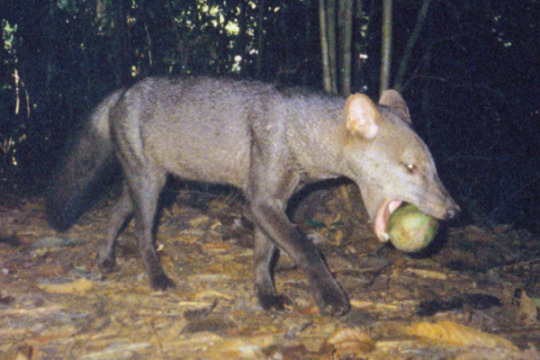
Much of what is known about these elusive animals comes from one short-eared dog named Oso, who was found when he was a puppy by a logger. He was then raised with pet dogs until a wildlife veterinarian named Renata Leite Pitman took over his care. By observing how Oso found food and interacted with other animals, Pitman learned about parts of the short-eared dogs’ life that scientists previously knew almost nothing about.
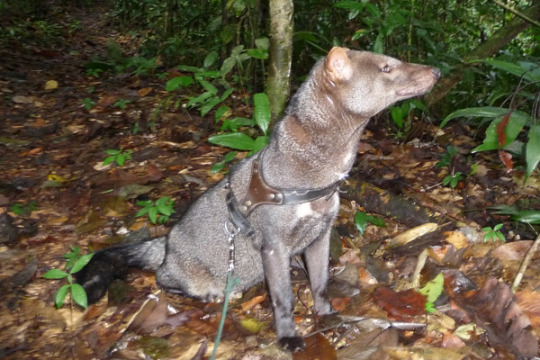
Before Pitman’s work with Oso, virtually nothing was known about short-eared dog vocalization, or the sounds they make. The veterinarian observed that Oso was very quiet but whined or “roared” when he was uncomfortable, and he occasionally made an unusual call that was “similar to some species of owl calls.”
When Oso was around 4 years old he was released into the wild with a tracker, allowing researchers to continue to learn about short-eared dogs.
I rate these very mysterious ghost dogs 13/10. They have a very distinctive look.

Photo credits:
(1) Galo Zapata-Rios (2) Owlcation (3) Renata Leite Pitman (4) Renata Leite Pitman (5) eMammal
#short eared dog#animals#biology#nature#science#wildlife#zoology#animal#dog#dogs#wild#canines#ghost dog#South American animals#South America#rainforest
2K notes
·
View notes
Video
(X) <-
#jaguar#big cat#big cats#animal#animals#fauna#video#animal videos#animal video#jaguars#feline#south american animals
168 notes
·
View notes
Text

Ok I pull up
#capybara#ok i pull up#animals#rodent#orange#orange fruit#my art#illustration#illustrator#animal art#wildlife#South American animals#capybara art#Artists on tumblr
27 notes
·
View notes
Text

Working away for Pickering Art Fest, I'm on the non art related prep now.
This capybara with an orange on his head is one if my favs I've made for this show, that little face just makes me happy.
And a brief announcement that the shop will be closed for the weekend, and all pieces in the shop will be joining me at the show. Not everything I bring will be coming back, so if you have your heart set on a piece, please be sure to grab them before Friday night.
13 notes
·
View notes
Text

Long-tailed sylph (Aglaiocercus kingii)
Photo by Fernando Burgalin Sequeria
#Aglaiocercus kingii#Aglaiocercus#long-tailed sylph#sylph#hummingbird#lesbiini#lesbiinae#south american birds#birds#blue#green#blue birds#green birds#tropical birds#nature#animals#wildlife#blue and green
2K notes
·
View notes
Text
For #Caturday:
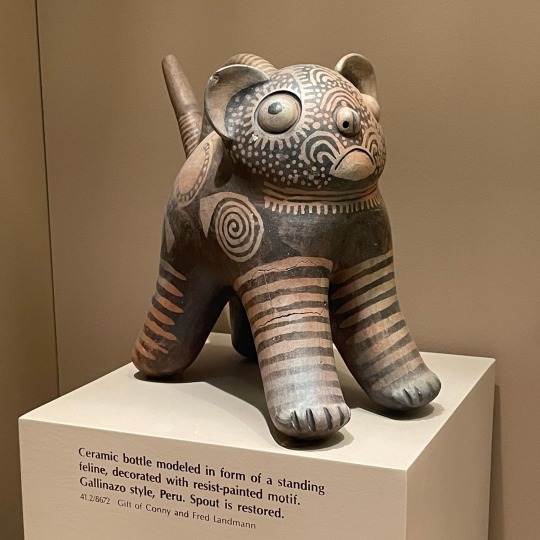
Ceramic bottle modeled in the form of a standing feline, decorated with resist-painted motif.
Gallinazo style (aka Virú culture), NW Peru, Early Intermediate Period, c. 200 BCE - 600 CE.
Spotted at the American Museum of Natural History NYC.
PS: this vessel may depict the Peruvian subspecies of Pampas Cat aka Northern Colocolo (Leopardus colocola garleppi). The Andean Mountain Cat (Leopardus jacobita) is also often suggested, but their range is more southern and higher elevation than where the Virú were? Also note the stripier legs on the Colocolo similar to the ceramic:
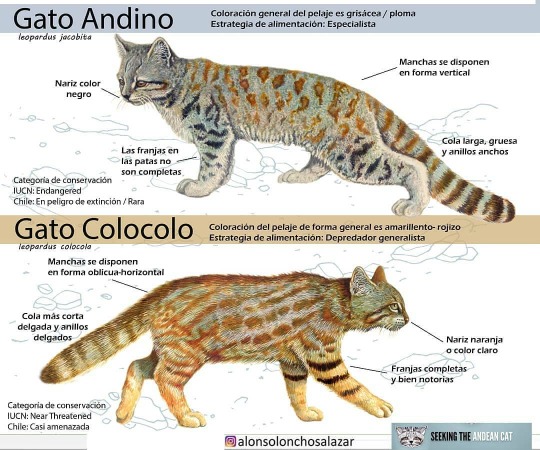
#cat#cats in art#feline#ceramics#effigy vessel#pre-conquest#Peruvian att#South American art#Indigenous art#Gallinazo#Virú#American Museum of Natural History#museum visit#Caturday#animals in art#Pampas Cat#Colocolo#Andean Mountain Cat#wild cats#mammalogy#zoology#species ID#ID#infographic#Peruvian art
2K notes
·
View notes
Text

What's this? A sabertooth longhorn beetle (Macrodontia cervicornis), which is native to South American rainforests. Bizarre and beautiful, yes?
2K notes
·
View notes
Text

#mine#one of my new fav photos#photo#photography#photographers on tumblr#texas#southern gothic#western gothic#rural#rural gothic#south west#western#americana#american gothic#digital#nature#landscape#country#gothic#there were so many bugs and animals out it was so lovely#spring is finally here#♡
2K notes
·
View notes
Text

Volcán Peteroa Chuckwalla (Phymaturus verdugo), male, family Liolaemidae, Argentina
photograph by Gdebandi
#phymaturus#south american chuckwalla#lizard#liolaemidae#reptile#herpetology#south america#animals#nature
200 notes
·
View notes
Text
There's this idea I've seen around occasionally, and it always baffles me, that participating in fandom for adult animation is somehow cringe or lesser than participating in fandom for anime/manga, video games, live action shows, or even cartoons made for kids. I don't understand it at all.
And when I say "participating in fandom" I mean people who draw Family Guy fanart, people who write South Park fanfic, people who ship Beavis and Butthead, and yes, even people who draw Marge Simpson as an e-girl or whatever.
I don't understand why there's this need by people to point out "man, it's CRAZY and WACKY and WEIRD that you're investing time into this media I don't consume!" Like thanks? Go back to talking about your silly thing and leave people alone.
Everyone has a right to engage in/find MEANING in media, whether you think it's the "wrong kind" or not. A show with dick jokes and crude, edgy humor can still have a lasting impact on the people who make it a part of their weekly routine to sit down and watch the new episodes, or even just revisit old ones when they're down.
I'm just saying that if you can sit down and form an emotional attachment to Lucky Star, an animated comedy full of references to its countries media and culture, I don't see why someone can't form an emotional attachment to something like Aqua Teen Hunger Force, an animated comedy full of references to its countries media and culture.
Sometimes people appreciate a piece of Media Produce beyond watching funny moments compilations on YouTube, and that's normal and fine and healthy. Draw Frylock and Master Shake kissing, it's okay. Write about Kenny and Butters as middle aged men in love. Draw Beavis and Butthead yaoi. Write Clone High yuri. Be free.
#family guy#south park#aqua teen hunger force#athf#beavis and butthead#metalocalypse#clone high#american dad#smiling friends#just tagging a bunch of adult animation bc I do think this is important ig#why is it fans of stuff like idk Owl House are more normalized than fans of idk Moral Orel
159 notes
·
View notes
Text


American bison (Bison bison). Sage Creek Campground, Badlands National Park, South Dakota.
#bison#american bison#buffalo#south dakota#national parks#badlands#mine#badlands national park#wildlife#nature#nature photography#ecology#north america#animals#wildlife biology#naturalist#photography#wildlife biologist#biologist#ecologist#mammals#original photographers#original photography on tumblr#original photography#hiking#camping
117 notes
·
View notes
Photo

Groove-Billed Ani (Crotophaga sulcirostris)
Family: Cuckoo Family (Cuculidae)
IUCN Conservation Status: Least Concerned
While many species of cuckoos are brood parasites that trick other birds into incubating their eggs and raising their young, the 3 species of large-billed, black-feathered cuckoos in the genus Crotophaga, known collectively as Anis, are not, and the Groove-Billed Ani (notable for being possibly the most common Ani species) is no exception: every Groove-Billed Ani lives in a small social group consisting of 4-10 individuals, with the number of individuals in a group always being even. This even numbering is the result of the way the flock is organised, as each flock is made up of 2-5 pairs of mates, and while each individual will only breed with their mate all individuals in the group work to establish and defend a shared territory and to construct a large, cup-shaped shared nest into which every female in the flock will lay eggs. Found in grasslands, shrublands and other open habitats, the Grooved-Billed Ani is native to much of northern South America and southern North America (although on occasion it may be observed as far south as northern Argentina and as far north as Canada as a vagrant) and feeds on fruits, seeds, insects and small vertebrates, with its large and extremely powerful beak being well suited to breaking hard seed shells as well as the exoskeletons and bones of prey. Throughout the majority of its range this species is resident (non-migratory), but in the northernmost extremes of its North American range it may seasonally travel south to avoid cold weather and low resource availability during the winter.
--------------------------------------------------------------------------
Image Source: https://www.inaturalist.org/taxa/1972-Crotophaga-sulcirostris
#Groove-Billed Ani#ani#anis#cuckoo#cuckoos#bird#birds#zoology#biology#ornithology#animal#animals#wildlife#South American wildlife#North American wildlife
932 notes
·
View notes
Text
Animal of the Day!
Lowland Tapir (Tapirus terrestris)

(Photo by Daniel Zupanc)
Conservation Status- Vulnerable
Habitat- South America
Size (Weight/Length)- 300 kg; 2.5 m
Diet- Leaves; Fruits
Cool Facts- The lowland tapir is the largest terrestrial animal of South America. Despite their mass and hoofed toes, these tapirs are excellent swimmers and can even dive underwater. During dawn and dusk, lowland tapirs leave their wetland home for the jungle to feast. Their prehensile nose helps to strip leaves and fruits from low hanging trees. After mating in the early summer, female lowland tapirs are pregnant for 13 months. The calf is born light brown with white stripes to help blend in with the forest floor. Calves stay with their mom for a little less than two years before leaving to fend for themselves. While these tapirs are threatened by poaching and habitat destruction, their numbers are still strong thanks to conservation efforts in protecting their rainforest home.
Rating- 11/10 (Some crazy classification history.)
#animal of the day#animals#mammals#tapir#tuesday#september 26#lowland tapir#south american tapir#biology#science#conservation#the more you know
175 notes
·
View notes
Text
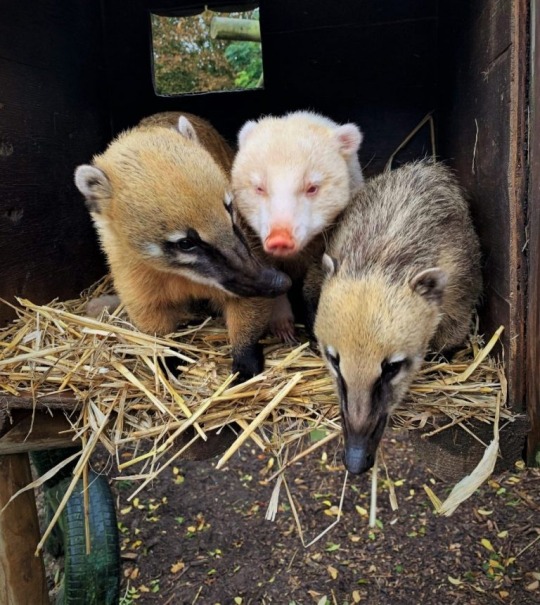
Albino South American coatimundi (Nasua nasua) with normal companions.
@ Wingham Wildlife Park
#albino#albinism#south american coatimundi#coatimundi#coati#nasua nasua#procyonidae#mutation#mammal#hey I’m going to do more simple single or double image posts more often than big complicated ones#as it takes less effort#I have two animal blogs now (one-weird-animal-a-day is the new one#and I think doing a lot of detail is what makes things difficult for me to keep up#sorry guys for the absence!
1K notes
·
View notes
Text

SUMMARY: A young woman takes refuge in a strange house in the woods after escaping from a German colony in southern Chile.
#the wolf house (2018)#animation#horror drama#2010s#chile#south american movie#horror#movies#poll#more than 50% havent heard
63 notes
·
View notes